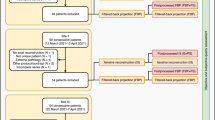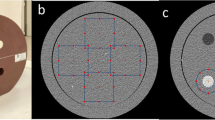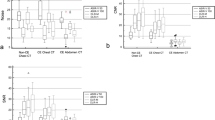Abstract
Objective
To quantitatively compare DLIR and ASiR-V with realistic anatomical images.
Methods
CT scans of an anthropomorphic phantom were acquired using three routine protocols (brain, chest, and abdomen) at four dose levels, with images reconstructed at five levels of ASiR-V and three levels of DLIR. Noise power spectrum (NPS) was estimated using a difference image by subtracting two matching images from repeated scans. Using the max-dose FBP reconstruction as the ground truth, the structure similarity index (SSIM) and gradient magnitude (GM) of difference images were evaluated. Image noise magnitude (σ), frequency location of the NPS peak (fpeak), mean SSIM (MSSIM), and mean GM (MGM) were used as quantitative metrics to compare image quality, for each anatomical region, protocol, algorithm, dose level, and slice thickness.
Results
Image noise had a strong (R2 > 0.99) power law relationship with dose for all algorithms. For the abdomen and chest, fpeak shifted from 0.3 (FBP) down to 0.15 mm-1 (ASiR-V 100%) with increasing ASiR-V strength but remained 0.3 mm-1 for all DLIR levels. fpeak shifted down for the brain protocol with increasing DLIR levels. Three levels of DLIR produced similar image noise levels as ASiR-V 40%, 80%, and 100%, respectively. DLIR had lower MSSIM but higher MGM than ASiR-V while matching imaging noise.
Conclusion
Compared to ASiR-V, DLIR presents trade-offs between functionality and fidelity: it has a noise texture closer to FBP and more edge enhancement, but reduced structure similarity. These trade-offs and unique protocol-dependent behaviors of DLIR should be considered during clinical implementation and deployment.
Key Points
• DLIR reconstructed images demonstrate closer noise texture and lower structure similarity to FBP while producing equivalent noise levels comparable to ASiR-V.
• DLIR has additional edge enhancement as compared to ASiR-V.
• DLIR has unique protocol-dependent behaviors that should be considered for clinical implementation.






Similar content being viewed by others

Abbreviations
- ASiR:
-
Adaptive Statistical Iterative Reconstruction
- DLIR:
-
Deep-learning image reconstruction
- FBP:
-
Filtered-backprojection
- MSSIM:
-
Mean value of SSIM
- NPS:
-
Noise power spectrum
- SSIM:
-
Structure SIMilarity
References
Hsieh J, Liu E, Nett B, Tang J, Thibault J, Sahney S (2021) A new era of image reconstruction: TrueFidelity—technical white paper on deep learning image reconstruction. GE Healthcare website. https://www.gehealthcare.com/-/jssmedia/040dd213fa89463287155151fdb01922.pdf. Accessed 2022
Wang G, Ye JC, De Man B (2020) Deep learning for tomographic image reconstruction. Nat Mach Intell. 2(12):737–748
Hata A, Yanagawa M, Yoshida Y, Miyata T, Kikuchi N, Honda O et al (2021) The image quality of deep-learning image reconstruction of chest CT images on a mediastinal window setting. Clin Radiol 76(2):155 e15–155 e23. https://doi.org/10.1016/j.crad.2020.10.011
Tamura A, Mukaida E, Ota Y, Kamata M, Abe S, Yoshioka K (2021) Superior objective and subjective image quality of deep learning reconstruction for low-dose abdominal CT imaging in comparison with model-based iterative reconstruction and filtered back projection. Br J Radiol. 94(1123):20201357
Parakh A, Cao J, Pierce TT, Blake MA, Savage CA, Kambadakone AR (2021) Sinogram-based deep learning image reconstruction technique in abdominal CT: image quality considerations. Eur Radiol. 31(11):8342–8353. https://doi.org/10.1007/s00330-021-07952-4
Nakamura Y, Higaki T, Tatsugami F, Zhou J, Yu Z, Akino N et al (2019) Deep learning–based CT image reconstruction: initial evaluation targeting hypovascular hepatic metastases. Radiol Artif Intell 1(6):e180011
Lyu P, Neely B, Solomon J, Rigiroli F, Ding Y, Schwartz FR et al (2021) Effect of deep learning image reconstruction in the prediction of resectability of pancreatic cancer: diagnostic performance and reader confidence. Eur J Radiol 141:109825. https://doi.org/10.1016/j.ejrad.2021.109825
Jensen CT, Liu X, Tamm EP, Chandler AG, Sun J, Morani AC et al (2020) Image quality assessment of abdominal CT by use of new deep learning image reconstruction: initial experience. AJR Am J Roentgenol. 215(1):50–57
Delabie A, Bouzerar R, Pichois R, Desdoit X, Vial J, Renard C (2021) Diagnostic performance and image quality of deep learning image reconstruction (DLIR) on unenhanced low-dose abdominal CT for urolithiasis. Acta Radiol. 02841851211035896
Singh R, Digumarthy SR, Muse VV, Kambadakone AR, Blake MA, Tabari A et al (2020) Image quality and lesion detection on deep learning reconstruction and iterative reconstruction of submillisievert chest and abdominal CT. AJR Am J Roentgenol. 214(3):566–573
Benz DC, Benetos G, Rampidis G, von Felten E, Bakula A, Sustar A et al (2020) Validation of deep-learning image reconstruction for coronary computed tomography angiography: impact on noise, image quality and diagnostic accuracy. J Cardiovasc Comput Tomogr. 14(5):444–451. https://doi.org/10.1016/j.jcct.2020.01.002
Oostveen LJ, Meijer FJA, de Lange F, Smit EJ, Pegge SA, Steens SCA et al (2021) Deep learning-based reconstruction may improve non-contrast cerebral CT imaging compared to other current reconstruction algorithms. Eur Radiol 31(8):5498–5506. https://doi.org/10.1007/s00330-020-07668-x
Park C, Choo KS, Jung Y, Jeong HS, Hwang JY, Yun MS (2021) CT iterative vs deep learning reconstruction: comparison of noise and sharpness. Eur Radiol. 31(5):3156–3164. https://doi.org/10.1007/s00330-020-07358-8
Brady SL, Trout AT, Somasundaram E, Anton CG, Li Y, Dillman JR (2021) Improving image quality and reducing radiation dose for pediatric CT by using deep learning reconstruction. Radiology. 298(1):180–188
Yoon H, Kim J, Lim HJ, Lee MJ (2021) Image quality assessment of pediatric chest and abdomen CT by deep learning reconstruction. BMC Med Imaging 21(1):146. https://doi.org/10.1186/s12880-021-00677-2
Li K, Tang J, Chen GH (2014) Statistical model based iterative reconstruction (MBIR) in clinical CT systems: experimental assessment of noise performance. Med Phys 41(4):041906. https://doi.org/10.1118/1.4867863
Solomon J, Lyu P, Marin D, Samei E (2020) Noise and spatial resolution properties of a commercially available deep learning-based CT reconstruction algorithm. Med Phys 47(9):3961–3971. https://doi.org/10.1002/mp.14319
Kawashima H, Ichikawa K, Takata T, Mitsui W, Ueta H, Yoneda N et al (2020) Performance of clinically available deep learning image reconstruction in computed tomography: a phantom study. J Med Imaging. 7(6):063503
Greffier J, Hamard A, Pereira F, Barrau C, Pasquier H, Beregi JP et al (2020) Image quality and dose reduction opportunity of deep learning image reconstruction algorithm for CT: a phantom study. Eur Radiol. 30(7):3951–3959. https://doi.org/10.1007/s00330-020-06724-w
Racine D, Brat H, Dufour B, Steity J, Hussenot M, Rizk B et al (2021) Image texture, low contrast liver lesion detectability and impact on dose: deep learning algorithm compared to partial model-based iterative reconstruction. Eur J Radiol 109808
Franck C, Zhang G, Deak P, Zanca F (2021) Preserving image texture while reducing radiation dose with a deep learning image reconstruction algorithm in chest CT: a phantom study. Phys Med. 81:86–93. https://doi.org/10.1016/j.ejmp.2020.12.005
Szczykutowicz TP, Nett B, Cherkezyan L, Pozniak M, Tang J, Lubner MG et al (2021) Protocol optimization considerations for implementing deep learning CT reconstruction. AJR Am J Roentgenol. 216(6):1668–1677. https://doi.org/10.2214/AJR.20.23397
Wang Z, Bovik AC, Sheikh HR, Simoncelli EP (2004) Image quality assessment: from error visibility to structural similarity. IEEE Trans Image Process. 13(4):600–612
Funding
The authors state that this work has not received any funding.
Author information
Authors and Affiliations
Corresponding author
Ethics declarations
Guarantor
The scientific guarantor of this publication is Kai Yang.
Conflict of interest
The authors of this manuscript declare no relationships with any companies whose products or services may be related to the subject matter of the article.
Statistics and biometry
No complex statistical methods were necessary for this paper.
Informed consent
Written informed consent was not required for this study because no human subjects were involved.
Ethical approval
Institutional Review Board approval was not required because no human subjects were involved.
Methodology
• experimental
• performed at one institution
Additional information
Publisher’s note
Springer Nature remains neutral with regard to jurisdictional claims in published maps and institutional affiliations.
Supplementary Information
ESM 1
(DOCX 1049 kb)
Rights and permissions
Springer Nature or its licensor (e.g. a society or other partner) holds exclusive rights to this article under a publishing agreement with the author(s) or other rightsholder(s); author self-archiving of the accepted manuscript version of this article is solely governed by the terms of such publishing agreement and applicable law.
About this article
Cite this article
Yang, K., Cao, J., Pisuchpen, N. et al. CT image quality evaluation in the age of deep learning: trade-off between functionality and fidelity. Eur Radiol 33, 2439–2449 (2023). https://doi.org/10.1007/s00330-022-09233-0
Received:
Revised:
Accepted:
Published:
Issue Date:
DOI: https://doi.org/10.1007/s00330-022-09233-0



